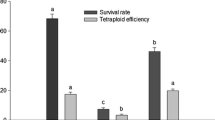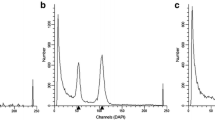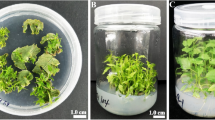Abstract.
This paper describes an efficient colchicine-mediated technique for the in vitro induction of hop tetraploids and its confirmation by flow cytometry. A window of conditions generated a high percentage (>20%) of tetraploid induction, with the highest induction (25.6%) achieved with 0.05% colchicine for 48 h. Colchicine-induced tetraploids remained stable after 6 months in soil. Leaf characteristics of diploid and tetraploid hops were compared, and it was determined that stomatal length and width are suitable parameters for identifying putative hop tetraploids. As well as generating tetraploids, this technique generates mixoploid hops. Calli, derived from mixoploid leaves, were induced to form shoot buds and shoots. Individual shoots were classed as diploid, mixoploid or tetraploid after screening by flow cytometry. This callus-based technique can be employed when a genome-doubling agent generates mixoploids but fails to generate tetraploids.
Similar content being viewed by others
Author information
Authors and Affiliations
Additional information
Electronic Publication
Rights and permissions
About this article
Cite this article
Roy, A., Leggett, G. & Koutoulis, A. In vitro tetraploid induction and generation of tetraploids from mixoploids in hop (Humulus lupulus L.). Plant Cell Rep 20, 489–495 (2001). https://doi.org/10.1007/s002990100364
Received:
Accepted:
Published:
Issue Date:
DOI: https://doi.org/10.1007/s002990100364




